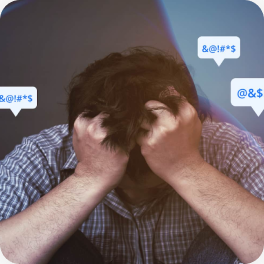How We Put a Stop to a Cyberbullying Case
At a time when digital media is an integral part of our lives, it is easy to forget there are real people behind the avatars on our screens. Every word we type conveys emotion, thoughts, and ideas that have the potential to significantly impact another person. Cyberbullying has become prevalent with increased social media use and is now a persistent problem. This is especially concerning because it is often hardly visible to adults, and children are reluctant to report it because of the potential backlash they may face.
Cases of cyberbullying are increasing slowly but steadily. Statistics by the United States government suggest that 15% of students aged 12-18 have been victims of cyberbullying and 14.9% of students had been victims of cyberbullying in the year prior to the survey.

A Case in Point
We recently resolved a sensitive case involving a fake account that posted defamatory content about our client.
In the fall of 2021, James* told his aunt and uncle about an Instagram account that was impersonating him and posting horrible and ugly pictures.
James suspected the bully was a member of a friendship group he’d grown apart from due to their differing interests and thought they may be feeling hurt because the friendship had ended.
The bully used pictures taken when he and James had been hanging out together as content on the fake account. This led to James being teased and humiliated at school, with fellow classmates calling him by the name used on the fake account. James tried reporting the account to Instagram multiple times, but he didn’t have any success, so he gave up.
The fake account had been in existence for a year when his uncle took up the matter. He was directed to Instagram’s web page that gave detailed instructions for what a user can do if someone else is impersonating them.

James’ uncle took a picture of James holding his ID to prove the account they were reporting was fake. His uncle sent this information to Instagram but never got a reply, or an update on the status of his complaint, or even a notification to say his email had been received.
James’ uncle felt hugely frustrated by the lack of resources online about how to solve cases of cyberbullying and information about service providers that can help stop cyberbullying.
He found an article on our website about cyber bully and another about online reputation management. He saw value in both these services in relation to his nephew’s situation. Inaccurate information posted about James was harming James’ reputation at school, because it was hard to distinguish the real account from the fake one. Hence, he reached out to us for advice and help.
How Can a Case of Cyberbullying be Addressed?
We first took the standard route of reporting the activity through official channels globally, even though it has been our experience, unfortunately, that despite the scale of Facebook and Meta, this route has never been fruitful. After two months of no success, we engaged our legal team. We worked with a group of lawyers to send a certified letter to our contacts at Facebook, and follow up relentlessly. As a result, we finally had James’ case addressed and the fake account taken down.
What Should You Do If Your Child Is a Victim of Cyberbullying?
- Listen without judgment, empathize with the victim, and reassure them there is a solution. James’ uncle assured him he would find a way to fix the situation. Our team also gave James’ uncle hope by doing everything we could to solve the matter.
- Talk to the victim about the best approach for dealing with the bullying. Ultimately, the solution should ease the victim’s emotional burden. For example, reaching out to the bullies and asking them to stop may seem like the most straightforward approach, but unfortunately, the victim may then face retaliation. The bullies may find new ways to torment the victim or they may escalate the frequency of attacks. Because adolescent relationships are close and often volatile, it is easy for teenagers to regroup and find a new tactic. Word that a parent reached out on behalf of their child will quickly spread, and the outcome could be a more severe form of bullying. It’s best to ask the victim what they would like to do, calmly discuss all options and possible outcomes, and support them in every way possible.
- Consider hiring a defamation attorney. How can they help? Lawyers’ words have authority and carry weight. In James’ case, the account was reported on ten different occasions by our global team with no success. The account was only taken down after a certified letter from a defamation attorney was sent to key contacts at Facebook.
- If the bullying continues, threaten to file a police report. This could result in the bully carrying around a tarnished reputation for the rest of their life and prompt them to reconsider their actions first.
What Challenges Am I Likely to Face?
- There is a risk of retaliation by the bullies once they find out the victim reported the matter to an adult and that something is being done about it.
- There is a risk that the bullies might create another fake account when the reported account is taken down.
- Parents also face the challenge of how best to maintain confidentiality for their child, the victim, while working to stop the cyberbullying.
Who Can be Targeted by Cyberbullying?
Anyone can be a target of cyberbullying, but those considered to be ‘different’ are at a greater risk. In James’ case, we suspected three factors played a part:
Children with disabilities – James had a learning disability that made school work difficult.
Children who are alienated from their peers – James didn’t have age-appropriate friends because he was behind by one grade due to his learning disability.

Children who struggle to form close friendships – It was difficult for James to form close friendships in his class because of differences in interests due to age. He also studied at a school that wasn’t local to where he’d grown up, forming further barriers.
What are the Consequences of Cyberbullying?
Cyberbullying is a complex issue and its effects are far-reaching. It is crucial that cyberbullying isn’t oversimplified, and that any studies of its effects reflect the nuances of the problem. Some of the general consequences are:
-
- An increased likelihood of self-harm due to feelings of helplessness.
- A reduction of trust within the close friendship group. James had a difficult time trusting his friends after the incident, as they had followed the fake social media account, effectively partaking in the cyberbullying.
- Onset of depression and anxiety.
- Poor academic performance.

According to The US Government’s Stop Bullying campaign, the effects of cyberbullying can impact the perpetrator too. Any content created or shared online by an individual forms part of their online public reputation, which may be accessible to schools, employers, colleges, clubs, and others who may be researching an individual now or in the future. These incidents become part of their official record and might be looked on unfavorably by a potential employer or college recruiter.
Each case of cyberbullying is unique. If you, or someone you know is experiencing cyberbullying, you can seek help from a number of organizations, including Blue Ocean Global Technology, who can provide support in resolving the case and restoring your online reputation.
Are You or Someone Close to You a Victim to Cyber Crime?. You Don’t Have to Face It alone.
We Are Here to Support You. Contact Us Today.



Comments are closed.